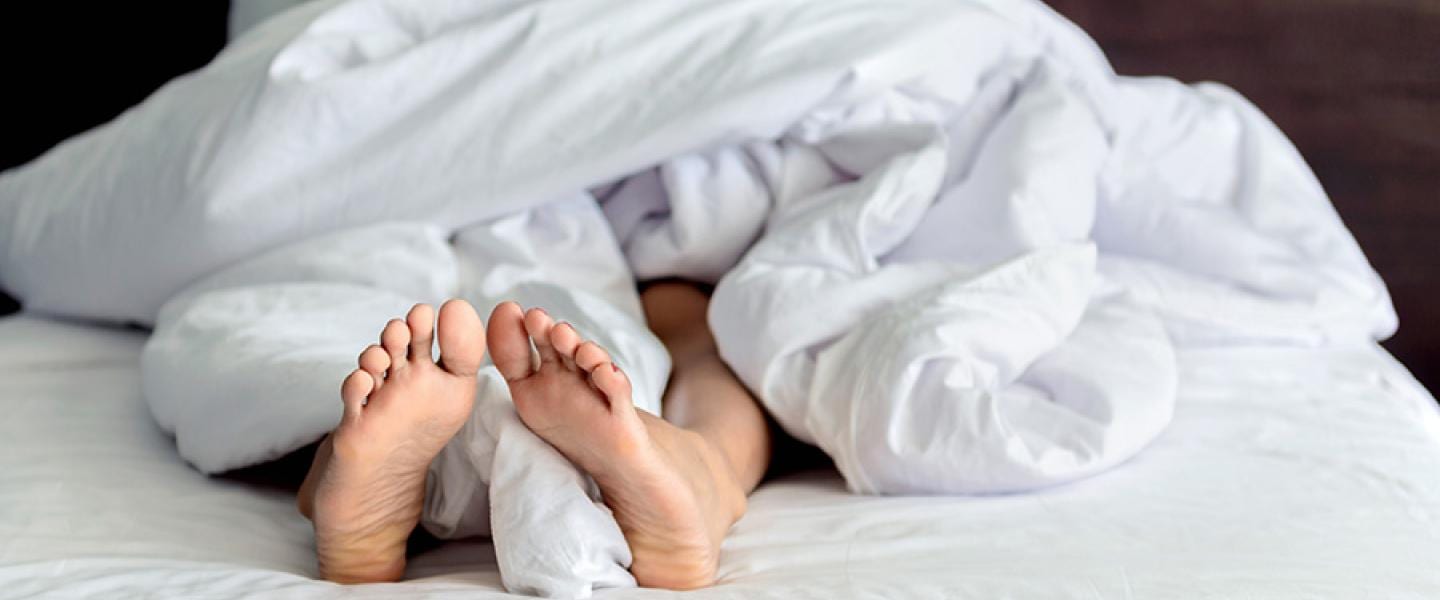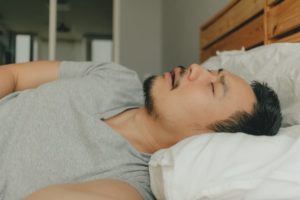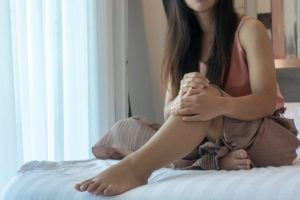Periodic Limb Movement Disorder
What it is, what it feels like, its possible causes, and how it's addressed
Some movement during sleep is normal, especially as you settle in for the night. For example, most people have experienced “sleep starts” or “hypnic jerks,” a harmless phenomenon that causes the body to suddenly jerk as a person is falling asleep . That said, most people’s bodies generally stay still during sleep . Repeated episodes of twitching, kicking, or flailing throughout the night can indicate that a person has a sleep-related movement disorder . One such condition is periodic limb movement disorder (PLMD).
Is Your Troubled Sleep a Health Risk?
A variety of issues can cause problems sleeping. Answer three questions to understand if it’s a concern you should worry about.
What Is PLMD?
PLMD stands for periodic limb movement disorder, a sleep disorder in which a person’s arms or legs twitch and jerk repeatedly during sleep . These movements are called periodic limb movements of sleep (PLMS). Between 4% and 11% of adults have PLMD, and the movements aren’t usually painful or uncomfortable. While they can include arm and hand movements, they most often involve:
- Flexing the foot and big toe backward
- Bending legs at the knees
- Bending legs at the hips
- Kicking
These movements happen in bursts that last between .5 and 10 seconds. Between bursts of movement, a sleeper often lies still for up to 90 seconds. These movements disrupt sleep for people with PLMD, even though they might not realize they are waking up throughout the night. These brief wake-ups can cause daytime tiredness and potential problems at home, school, or work.
PLMD is not the only disorder associated with periodic limb movements of sleep. These movements can also occur in people with restless legs syndrome, obstructive sleep apnea, narcolepsy, and neurological disorders such as Parkinson disease. Treatment of the contributing disorder may help to resolve the secondary movements.

What Causes PLMD?
Scientists are still trying to find the causes of periodic limb movement disorder (PLMD). Some research shows that low iron levels are linked to periodic limb movements, so iron deficiency may contribute to PLMD .
Another theory suggests that periodic limb movements happen during sleep when nerves in the spinal cord make mistakes while sending signals . Relatedly, other experts have proposed that in people with PLMD, the nerve pathways involved in limb movements become hyperexcitable during certain points of the sleep cycle, potentially because of low levels of dopamine, a neurotransmitter and hormone involved in pleasure, movement, and motivation.
Although there is still uncertainty about the causes of PLMD, research has clearly shown that some people have a higher risk of developing periodic limb movements of sleep than others. These include:
- Older adults
- Men and people assigned male at birth
- Individuals with obesity
- People with diabetes
- Smokers
- People with low iron levels
- People with low magnesium levels
- Individuals with inactive lifestyles
- People who take antidepressants
What Are the Symptoms of PLMD?
Repetitive leg and arm movements during sleep are the primary symptoms of periodic limb movement disorder (PLMD), but many people with the disorder aren’t aware of these movements. While periodic limb movements can disturb sleep, people who experience them usually don’t wake up for long enough to recall them. Other PLMD signs and symptoms include:
- Excessive daytime sleepiness: The sleep disturbances caused by PLMD lead to fragmented, low quality sleep and, ultimately, excessive sleepiness during the day.
- Decreased ability to function: Sleepiness and sleep deprivation caused by PLMD may interfere with a person’s ability to maintain relationships, fulfill work responsibilities, or do school work .
- Mood alterations: PLMD may lead to moodiness or distress.
- Accounts from bed partners: Bed partners may describe having their sleep interrupted by movements that shake the bed or complain about being kicked.
- Sleep difficulties: For some people, PLMD can trigger insomnia symptoms, making it difficult to fall asleep or stay asleep at night.
How Is PLMD Diagnosed?
Doctors diagnose periodic limb movement disorder (PLMD) by confirming a high number of periodic limb movements during sleep and ruling out other conditions that could be causing those movements. If you suspect you have PLMD, your doctor will likely begin by asking questions about daytime tiredness, reports from your sleeping partner, and other possible indicators of PLMD.
Your doctor might ask:
- If any pain or discomfort accompanies the limb movements
- Whether you are aware of movements when they take place
- If your entire body moves during episodes, or just your limbs
Questions like these can help your doctor differentiate PLMD from other conditions.
If your doctor thinks you might have PLMD, you may be asked to undergo an overnight sleep study in a specialized facility. During a sleep study, medical professionals record muscle activity to identify periodic limb movements. Adults must experience more than 15 distinct bursts or series of movements per hour and children must have more than five per hour for an official diagnosis of PLMD.
You may be asked to undergo additional testing, such blood tests such as a ferritin check to measure your iron levels, to help determine treatment decisions. If the ferritin level is <70 mcg/L blood, this may be deemed abnormal (even if it is technically within the normal laboratory range for adults).
What Are the Treatments for PLMD?
Research on possible treatments for periodic limb movement disorder (PLMD) is limited, and some experts question whether or not the disorder should be treated at all . If medical tests have revealed an iron deficiency, your doctor may recommend taking iron supplements or an intravenous iron infusion. Melatonin supplements, which are the body’s natural sleep hormone, may reduce limb movements in some people with PLMD.
Limited evidence suggests that certain prescription drugs may improve symptoms for some people with PLMD. These include medications such as ropinirole or pramipexole that activate dopamine receptors in the brain and that stabilize the electrical activity of certain nerves. Some prescription sedatives, such as clonazepam, have been shown to improve sleep in people with PLMD, but these may not be commonly recommended, as they don’t actually reduce movements caused by the disorder.
If you’ve been diagnosed with periodic limb movement disorder, talk to your doctor about what treatment options might be right for you.
Medical Disclaimer: The content on this page should not be taken as medical advice or used as a recommendation for any specific treatment or medication. Always consult your doctor before taking a new medication or changing your current treatment.

Still have questions? Ask our community!
Join our Sleep Care Community — a trusted hub of sleep health professionals, product specialists, and people just like you. Whether you need expert sleep advice for your insomnia or you’re searching for the perfect mattress, we’ve got you covered. Get personalized guidance from the experts who know sleep best.
References
11 Sources
-
Alghamdi S. A. (2023). Hypnic Jerks, major depressive disorder, and antidepressant Use: A possible relationship. Cureus, 15(10), e47436.
https://pubmed.ncbi.nlm.nih.gov/37869048/ -
Vaughn, B. V. (2024, June 11). Approach to abnormal movements and behaviors during sleep. UpToDate.
https://www.uptodate.com/contents/approach-to-abnormal-movements-and-behaviors-during-sleep -
Siegel J. M. (2005). Clues to the functions of mammalian sleep. Nature, 437(7063), 1264–1271.
https://pubmed.ncbi.nlm.nih.gov/16251951/ -
Schwab, R. J. (2024, June). Periodic Limb Movement Disorder (PLMD) and Restless Legs Syndrome (RLS). Merck Manual Professional Version.
https://www.merckmanuals.com/professional/neurologic-disorders/sleep-and-wakefulness-disorders/periodic-limb-movement-disorder-plmd-and-restless-legs-syndrome-rls -
Ondo, W. G. (2023, July 17). Clinical features and diagnosis of restless legs syndrome and periodic limb movement disorder in adults. UpToDate.
https://www.uptodate.com/contents/clinical-features-and-diagnosis-of-restless-legs-syndrome-and-periodic-limb-movement-disorder-in-adults -
Joseph, V., & Nagalli, S. (2023, February 14). Periodic limb movement disorder. In StatPearls. StatPearls Publishing.
https://www.ncbi.nlm.nih.gov/books/NBK560727/ -
Li, J., Moore, H., 4th, Lin, L., Young, T., Finn, L., Peppard, P. E., & Mignot, E. (2015). Association of low ferritin with PLM in the Wisconsin Sleep Cohort. Sleep Medicine, 16(11), 1413–1418.
https://pubmed.ncbi.nlm.nih.gov/26498245/ -
Rijsman, R. M., Stam, C. J., & de Weerd, A. W. (2005). Abnormal H-reflexes in periodic limb movement disorder; Impact on understanding the pathophysiology of the disorder. Clinical Neurophysiology: Official Journal of the International Federation of Clinical Neurophysiology, 116(1), 204–210.
https://pubmed.ncbi.nlm.nih.gov/15589198/ -
Miglis M. G. (2016). Autonomic dysfunction in primary sleep disorders. Sleep Medicine, 19, 40–49.
https://pubmed.ncbi.nlm.nih.gov/27198946/ -
Picchietti, D. L. (2023, July 5). Restless legs syndrome and periodic limb movement disorder in children. UpToDate.
https://www.uptodate.com/contents/restless-legs-syndrome-and-periodic-limb-movement-disorder-in-children -
Silber, M. H. (2024, June 14). Management of restless legs syndrome and periodic limb movement disorder in adults. UpToDate.
https://www.uptodate.com/contents/management-of-restless-legs-syndrome-and-periodic-limb-movement-disorder-in-adults






























